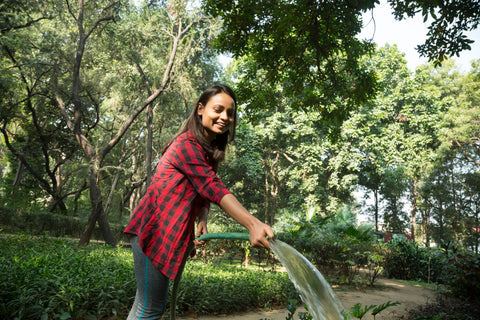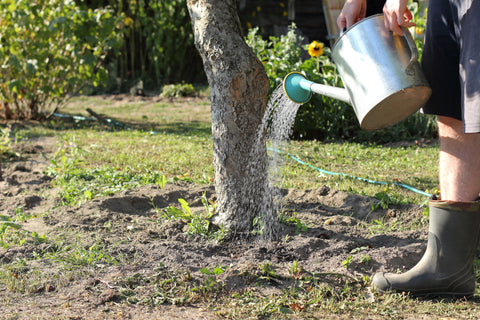I don’t know about you, but I’m glad we are in August—it means we’re getting closer to FALL! In the meantime, life is hot, but the garden continues to need attention. I’m thinking of putting flood lights all over my yard so that I can tend to my plants before the sun comes up.
Not only is it hot, but we’re also short on rain in many areas. Mulch is the first step for solving this problem. I think I say it in every article, but I just want to make sure everyone knows: As mulch decays, we need to continue to add more to maintain the moisture in the soil. Remember, decaying mulch feeds the soil, so you’re actually feeding the plants!
Water and Keeping Your Trees Healthy

Let’s talk about our trees. They also need water in this hot weather. But it takes more than just putting a sprinkler near your trees. First, deeper watering is better than shallow and frequent watering. In other words, when you water your trees, make sure you take time to give the deep roots a drink. If it’s a newly planted tree, it will need at least five gallons of water a week (you can do this in one go!).
Taking Care of the Dripline
The roots of a tree need the water, so point your garden hose toward the trunk all the way to the dripline.
To understand the dripline, think of an open umbrella during rain. The rain drips off of the outside edges in a circle that is the same size as the umbrella. Translate this to a tree. Most of the rain drips to the ground in a circle the same breadth as the canopy of the tree. This circular area is the dripline for most trees—it’s also the critical root zone!
Understanding the Critical Root Zone
Why do we call this area the critical root zone? Just as the name implies, these roots are the most important roots for the tree. These roots need the most protection to keep the tree healthy. Disturbing this area with trenching, paving or digging will most likely damage the tree.
Not All Trees Have the Same Zone
Different trees have different critical root zones varying in depth and spread. An oak tree, for example, has a critical root zone far beyond the canopy of the tree. No matter its size, the critical root zone is the best place to water, fertilize, and mulch this tree. (Remember: When mulching, start putting down the mulch 1 to 2 feet out from the trunk and then all the way to the dripline.)
Avoid Watering the Leaves!

Back to watering. Water the roots and not the leaves. Doing this will prevent fungal infection on the tree. When the leaves are wet, they will often scorch which interferes with transpiration. Transpiration is just one gift from our trees. Along with shade, trees release water into the air which helps keep us cooler.
A quick tip: Water early in the morning for trees as well as other plants and grass. This will avoid interference with transpiration
Why Trees Rock
Our trees are so very important to our environment—and they raise home values! I read an article that said homes (in Portland, Oregon) with street trees sold for around $7,000 more and nearly 2 days more quickly than those without trees. And houses within 100 feet of street trees sold for over $1,500 more, on average. Being near street trees had the same value as adding 129 square feet of finished space.
Plus, trees help clean our drinking water. According to the U.S. Forest Service, forested watersheds help “provide quality drinking water to more than 180 million Americans.”
Planting season is coming—KEEP PLANTING TREES!
Love our Ask a Master Gardener column? Check out Phyllis's previous columns here!




